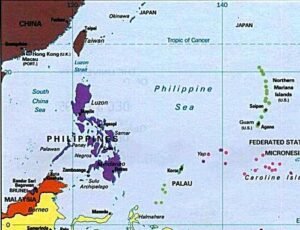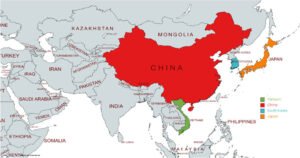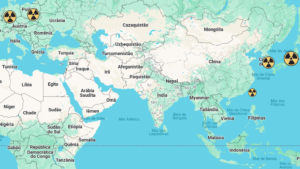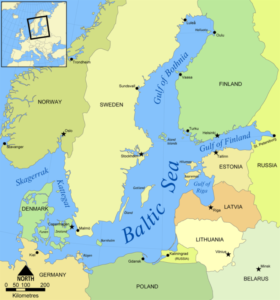- Undersea cables are deployed on the sea floor to carry communication signals;
- Physical and digital damage to backbones can have consequences for communication, financial transactions, international trade and state defense;
- The geopolitical conflicts projected in the digital media have increased the concern of countries to protect the communication cables that feed them.
Submarine cables are fundamental for data transmission and, in general, they are commonly used in international telecommunications networks connecting countries and continents, being essential for the integration of nations in the “International System.”
Due to such importance, communication cables have become a security issue in International Relations and a concern for state leaders who seek to protect them against possible attacks, especially with the increase in international tension with the war in Ukraine.

Source: TeleGeography
The history of using submarine cables for communication
Submarine communications cables, known as backbones, are cables laid on the sea floor between land stations to carry telecommunications signals across stretches of ocean.
The first of more than 400 submarine cables that now connect the world was laid in 1850, connecting England and France. Eight years later, the second cable was installed in the Atlantic.
This time it was 4,000 kilometers long and 1.5 centimeters wide. The objective was to connect Europe to the United States allowing telegraphic communication between the two continents.
The first submarine communications cables carried telegraph traffic, establishing the first instantaneous telecommunication links between continents. After the first ones, the most current cables began to carry telephone traffic and, finally, data traffic, that is, the internet.
Today’s cables use fiber optic technology to carry digital data, which includes telephone, Internet and private data traffic.
Why are undersea communication cables essential for national defense, commerce, and geopolitical influence?
Countries around the world are increasingly dependent on technology in general and for interconnection with the rest of the world, so the importance of protecting cybernetic systems against attacks has become one of the highest state priorities.
Vulnerability in a country’s technological structures makes room for possible unwanted foreign interference, compromising the various supply chains that meet the nation’s needs.
High-speed internet connectivity and the ability to reach large geographic spaces are essential for commerce and communications across the world today.
That said, the interruption of the internet could compromise the protection and stability of financial networks, which would be at risk, as well as the entire international trade network, which would suffer inevitable consequences and chain delays.
If undersea cables were accidentally or intentionally cut, even just for a few hours, even the modern warfare capability of countries could be affected as the functioning of the cables encompasses communications and awareness in the field of conflict.
Today’s geopolitical struggles for power are also increasingly projected onto technological and digital media, including many countries and technology companies struggling to achieve technological superiority and control the global digital order.
At the same time, submarine cables end up being neglected by governments because they are interstate, intercontinental and because they are implemented by private initiatives, most of the time.
The cables are managed by separate consortia of companies or private entities, with virtually no international governance system. The cables do not have national flags, so legal ownership is divided among the various co-owners under a system of jurisdictions and nationalities, as well as conventions and negotiations of the international law of the sea.
This multi-jurisdictional extension of undersea cables beyond territorial seas also makes their protection and maintenance more difficult, compromising the security and resilience of data transfers, internet services and worldwide communication.
The main risks for submarine cables in the 21st century – how to secure them?
According to the Center for Strategic and International Studies (CSIS), undersea cables have two types of vulnerabilities: physical and digital.
But, the most common threat today is physical damage caused by fishing accidents, commercial transport, or even damage caused by underwater earthquakes.
However, the greatest concern for States is malicious threats. The two biggest risks are the destruction of the cables or the possibility of them being bugged, by a non-state entity or even by a spying country.
As an example, according to Deutsche Welle (Germany’s public news network), German Chancellor Olaf Scholz and Norwegian Prime Minister Jonas Haar Store called on NATO to protect underwater pipelines and communication cables due to an alleged ” Russia’s attention to transatlantic submarine cables, particularly in the Sea of the North Atlantic.
Objectives can be: to cut military or government communications in the early stages of a conflict, to eliminate Internet access for a target population, to sabotage an economic competitor, or to cause economic disruption for geopolitical purposes.
Actors could also pursue several or all of these goals simultaneously. However, more difficult and subtle than destroying the cables is recording, copying and stealing your data, so that it can be collected and analyzed for espionage.
To secure submarine cables, some of the measures that can be taken, according to strategic specialists are: increasing the sharing of intelligence between countries and allied entities; and conducting national cable project risk assessments. In addition, States can make use of their national navies, jointly, to patrol part of the length of these cables through the use of ships and submarines – manned or not.
In addition, it is necessary to: ensure the private sector’s commitment to security; develop national monitoring and repair capabilities; and adopt joint planning in case of major damage.
The importance of maintaining the security of submarine cables and the risks of using satellites as an alternative
The global network of submarine cables provides the necessary connections for a wide range of activities vital to our modern society, from financial transactions to global communications or international scientific cooperation.
Submarine cables carry about 97% of all global communications, and an estimated $10 trillion in financial transfers every day.
Satellites, which are also important for global communication, are limited in speed and only handle a small percentage of global communications.
Compared to satellites, undersea cables also provide more reliable, cost-effective and high-capacity connections that are indispensable for today’s humanity. Furthermore, fiber optic cables are faster, cheaper and less risky than satellite communications.
It is estimated that between active satellites and space junk, there are more than 26,000 objects currently circling Earth’s orbit, causing a stellar congestion and an excess of objects in Earth’s orbit that increases the risk of collision.
Thus, submarine data transmission cables are the main connection line between different countries for commercial, political and even military use. In an increasingly interconnected world, they are the lifeblood of modern society.
Therefore, investment in the security of submarine cables is becoming an extremely important agenda in the strategic and national defense sectors and, consequently, an even more relevant topic in world geopolitics.














[…] Munich Security Conference covers a wide range of international security and geopolitical topics every year. Some of the main topics that have been discussed at Congresses […]
[…] if there are submarine cables connecting the world and they are essential for the transmission of information, this is an old […]